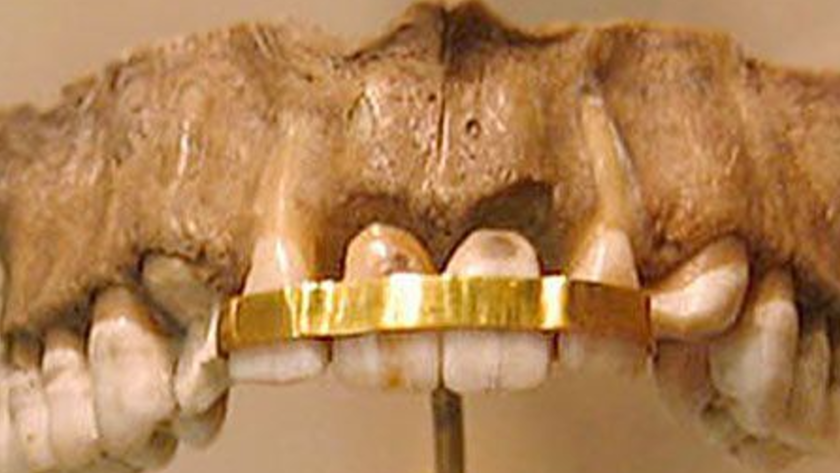Have you ever wondered what the history of dental braces was? Where did these metal items come from? What were early versions like?
We’re going to take a look at the history of braces that have been used to straighten your teeth and help you have a winning smile. What you will learn is that these items have been around much longer than you might have expected, but you certainly would not have wanted to have a set of early braces put on your teeth. Over the history of these items, advancements and technology have come a long way.
Crude Designs Found Long Ago
You might think that dental braces were something that came about with modern medicine, or at least in the past couple of centuries and not from long ago. The very first braces were crudely designed, and our modern historians didn’t know about these items until mummies in ancient Egypt were unearthed and studied. These previous rulers and dignitaries of the time had crudely designed braces that were used to try and correct broken or crooked teeth.
The early examples of these items were made of cord from animal skin and attached to the teeth in much the same way that dentists attach them today. While the cord material isn’t used any longer, the fact that the material was called “cat gut” gives us the idea that having braces put on in ancient times was probably more painful than it is today.
The next example we see in the history of braces being put on teeth was as early as 1000 BC. Archaeologists have seen devices that were affixed to teeth in Ancient Greece by the Etruscans to prevent the teeth from collapsing inward after some of the decay of the body had taken place. This group of ancients preceded the Romans in their homeland of Italy.
Working on Living Teeth
We can only guess that both the Egyptians and the Etruscans straightened teeth after the death of a person to give them something better to enjoy in the afterlife. In both cultures, an afterlife was believed in, but in different ways. The first recorded attempt to straighten teeth among the living took place during Roman times. Aulus Cornelius Celsus was the first to document his attempts at straightening teeth.
The way he went about it was to use the force of his own hand while applying pressure at different points. He also used a series of wires that had to be run through or around some teeth for the pressure to bring teeth together. Celsus reported some success in his experiments, but it’s hard to show that he truly had any success in his ventures. Regardless of his success, these were the first attempts in history to use a type of braces to straighten teeth on living people.
The Next Reported Attempts Were Several Decades Later
We don’t have any recorded attempts at dentistry from the times of the Roman Empire until the British and French Empires began. Most of that time was considered the Dark Ages, and when the world was ravaged by plague, the Crusades, and the discovery of new lands, which left little importance or time to worry about teeth.
Our next venture in the history of braces was found in France between 1728 and 1757. During this time, a pair of books were written about dentistry, one by Pierre Fauchard and one by Pierre Bourdet. Fauchard covered orthodontics and surgical procedures in his book, offering several different ways to straighten teeth. He created an item called a Bandeu, which was a crude mouthguard that could be used to keep teeth in their desired position in the mouth.
Bourdet, while serving as the dentist to the King of France, made improvements on the Bandeu, created by Fauchard. Not only was he able to improve the device, but he also discovered the rear wisdom teeth could be removed and allow the mouth to be less crowded. This was the cause of crooked teeth for many adults, which is still the case today, and removing these teeth proved effective and useful for many of his patients.
Modern Braces in the Wild West of Dentistry
The first set of modern braces were created by Christophe-Francois Delabarre in 1819, but they were a rudimentary device that has been altered and improved upon over the past couple of centuries. History tells us the first set of modern braces was a wire crib that was placed over each set of two teeth. To improve upon this system, Dr. Edward Maynard added elastic bands to the system to help improve the alignment of the jaw.
This addition took place in 1843, giving us a set of braces that were more like modern versions than anything we had seen previously. While this system was effective, the design was improved three years later by E. J. Tucker to make braces a bit more comfortable for the patients getting them.
Later, Dr. S. C. Barnum created a version of a dental dam, which is still in use today. Unfortunately, during this time, most of the dentists that were practicing would remove teeth to add their own form of braces to help straighten the teeth. Many patients would then go without some teeth for the rest of their lives just to have braces that were meant to straighten their remaining teeth.
Braces in Modern Times
Today, we see the use of stainless steel, better dental adhesives, and a variety of colors that can be chosen to give braces a modern look. There are even some invisible items that can be worn overnight to help give a person a straighter smile instead of having a dentist or orthodontist put a set of braces in your mouth.
It’s amazing to think the history of braces began with ancient people putting wires and items in the mouths of the dead to modern times with items you can order online and use to straighten your teeth while you sleep. Advancements in braces and dental technology have come a long way since the early Egyptian mummies.
This post may contain affiliate links. Meaning a commission is given should you decide to make a purchase through these links, at no cost to you. All products shown are researched and tested to give an accurate review for you.




